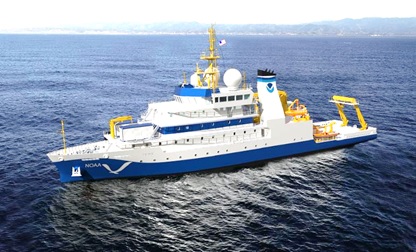Program Summary
 |
|
NOAA Vessel OCEANOGRAPHER off the coast of Hawaii
(Drawing courtesy of Thoma-Sea Marine Constructors)
|
Two NOAA AGOR vessels are being acquired through an agreement between the Navy and NOAA as part of NOAA’s fleet recapitalization plan. Once in service, the new ships will support a wide variety of missions, ranging from general oceanographic research and exploration to marine life, climate and ocean ecosystem studies. These missions include shallow coastal, continental shelf, and worldwide ocean survey and data collection; as well as launching work boats, performing maintenance on buoys and moorings, collecting weather and water column data, and performing bathymetric surveys at sea. These vessels will allow researchers to remain on station at remote locations for multiple days to collect data, deploy scientific equipment, and perform scientific analyses.
The two new ships will greatly enhance NOAA’s ocean exploration and scientific research capabilities. The first ship, OCEANOGRAPHER, will be homeported in Honolulu, HI. The second ship, DISCOVERER, will be homeported in Newport, RI. Both ships will continue the legacies of their namesakes, the first OCEANOGRAPHER having served in the NOAA fleet from 1966 to 1996 and her sister ship, DISCOVERER, from 1967 to 1996.
Designed as mono-hull ships, the OCEANOGRAPHER and DISCOVERER will be 244.5 feet in length and built to commercial standards. They will incorporate the latest technologies including high-efficiency environmentally friendly EPA Tier IV diesel engines, emissions controls for stack gases, new information technology tools for monitoring shipboard systems, and state of the art scientific underwater research and survey equipment. Each vessel will operate with a crew of 20 with accommodations for up to 28 scientists.
Both ships are being built in Houma, LA by Thoma-Sea Marine Constructors LLC and will be delivered to NOAA to be operated by NOAA Corps officers and civilian professional mariners to support NOAA missions.
The Navy has been a leader in building and providing large research ships for the nation's research fleet since World War II. These new NOAA ships are the first step in supporting NOAA with its fleet recapitalization effort.
Updated February 2023